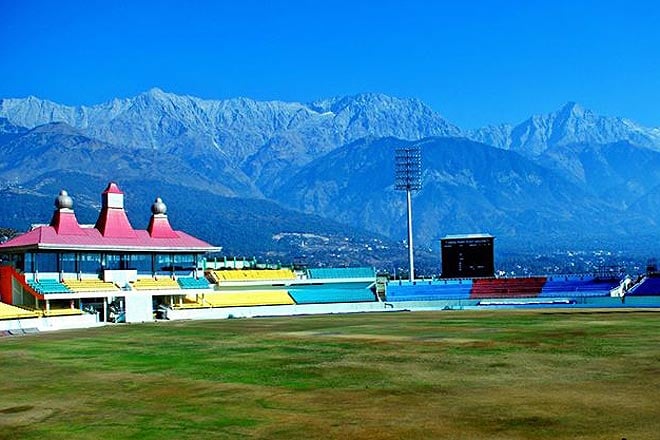Dharamsala
It is easy to fall prey to the Tibetan charm of Dharamsala – the august presence
Bhagsu Nag Temple
Only 2km from Mcleodganj, the Bhagsu Nag Temple is located within a Gaddi tribal village. A hilly spring runs through the temple. About 1.5km away is a waterfall that jumps down 20 feet.
Chamunda Devi temple
With the Dhauladhar range as its background, this famous Devi temple of the valley also offers a view of the Baner khud and the Lahla forests. It is about 15km away from Dharamsala.
Cricket Stadium
Perched at 4,780 feet, the cricket stadium is overlooked by the snow peaks of the Himalayan ranges. The first international match was played between India and Pakistan in 2005.

Dal Lake
About 4km away from Mcleodganj, the Dal Lake (not to be confused with the lake in Srinagar, J&K) is surrounded by a forest of Deodar trees. A popular picnic spot, it is also the venue of an annual fair held on the day of Radhastami (September 21 in 2015).

Dharamkot
To catch a sweeping view of the Kangra valley and the surrounding snow peaks, you can visit the viewing point at the top of Dharamkot (11km from Dharamsala).
Indru Nag Temple
Another place to catch a sweeping view of the snow peaks and the valley. The temple, 5km from Dharamsala, is dedicated to a snake deity called Indru Nag.

Kangra
About 17km away from Dharamsala, Kangra town can be your base for a holiday into the eponymous valley. You can also take joy ride in the Kangra Valley toy train that passes through the town, running on a narrow gauge track between Pathankot and Jogindernagar.

Kareri Lake
The Kareri Lake lies within a meadow that recedes into the forests of oak and pine. This high-altitude shallow fresh water lake is about 9km west of Dharamsala. The lake remains frozen between early December and April. Kareri Lake serves as a base for trekking further into the Dhauladhar and onward to Chamba and Bharmour via the Minkiani and Baleni Pass.

Naddi
You can carry on for 1.5km more beyond Dal Lake and visit the Naddi sunset point, which offers a nice view of the snow peaks and surrounding countryside. Those who love trekking, can follow the trails to Kareri Lake, Guna Devi Temple or Triund.

St. John’s Church
Forsythganj, on the upper reaches of the Dharamsala town, still retains memories of the colonial days, especially the in the St John’s Church.

Triund
You can trek up to Triund, perched above Mcleodganj (the seat of the Dalai Lama), for a panoramic view of the snow peaks. The 9km trek is not easy and usually takes four hours; another two hours of arduous trekking will take you to the snow line.
Excursion:
Haripur
About 52km away from Dharamsala, Haripur was the capital of the former princely state of Haripur-Guler. Apart from its early 15th century fort, Haripur-Guler has a number of old temples, wells and gates. It was also one of the main centres where the Pahari school of painting flourished. The nearby Maharana Pratap Sagar wetland is known for its avian visitors, especially in winter.
Jawalamukhi
About 53km away from Dharamsala (and 35km from Kangra town), lies Jawalamukhi. The old temple with its golden dome (the gilding was sponsored by Maharaja Ranjit Singh) is one of the much revered temples in India. It is said to be the place where Sati’s tongue fell. The flame in the rock, representative of Goddess Shakti, is said to burning eternally. The Navaratri celebrations draw a lot of crowd. You can also visit the Chintpurni Temple (35km away from here) where Sati’s feet fell and the Maharana Pratap Sagar dam.
Machhial
At a distance of 25km from Dharamsala, the pilgrim town of Machhial is the gateway to the Tatwani hot springs, 6km away, on the banks of the Gaj river, a tributary of the mighty Beas. The Jhamakara folk dance is said to have originated from the nearby Nerti village.
Masroor
Hidden in the Kangra valley, about 40km from Dharamsala, is this block of 15 rock cut temples. The richly carved 8th century monolithic temples resemble the Kailash Temple of Ellora in Maharashtra. It is maintained by the Archaeological Survey of India and charges a nominal entry fee.
Nurpur
About 66km from Dharamsala, Nurpur is named after the Moghul queen Nur Jehan (wife of emperor Jehangir). Apart from its old fort and Krishna Temple, it is also known for manufacturing of pashmina textiles, including shawls. It was also an important centre of the Pahari school of painting.
Trilokpur
About 41km away from Dharamsala, the Trilokpur cave temple has a fine display of stalactite and stalagmite formations.
Access: The nearest airport is at Gaggal, 13km from Dharamsala. The nearest broad gauge railway station is at Pathankot 85km away. HPTDC operates a luxury coach between Delhi and Dharamsala.
Dalai Lama
Dharamkot
Dharamsala



